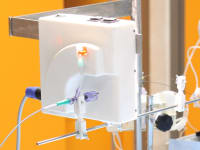
ROSES is a Robotic System for Endovascular Surgery, composed by a console, the master, that can control up to three slaves, and a number of disposables (at least one per each slave) that allows driving guide wires and catheters into the human body, separating the doctor from the patient, in order to eliminate ionized radiations for the doctor.
In particular the system is able to provide very fine motion control during angioplasty, using a single slave and a dedicated disposable. But using two slaves in series, it is possible to drive an initial catheter with the slave closer to the patient, and a guide wire even with movable core with the second slave. Each slave can control three parameters, that can be advancement retraction of a balloon catheter, advancement retraction of the guide wire for angioplasty, and their common rotation, or advancement retraction and core motion of a guide wire during the initial part of an endovascular surgery.
The system allows also measuring the force opposed to the advancement of the catheter or guide wire representing this on the screen of the monitor enclosed in the master as a column initially green that turns into red as the force becomes too high. ROSES also allows to control two slaves placed in parallel during angioplasty, which may be needed if a stenosis is close to a coronary branch, in which case inflating the balloon or stent to open the stenosis one may risk closing the coronary branch. In this case it is enough to place a second angioplasty disposable in the slave on the side, drive a second guide into the branch, then inflate the balloon, and, if this caused closing the branch, reopen it with a second balloon. All mechanical components were designed with a CAD modeller, and built in nylon with 3D printing equipment.
Currently there is a maker of Angioplasty robots, Corindus, and a maker of a system for endovascular surgery, Hansen Medical, both without measure of the force opposed by the body to the penetration of the catheter / guide wire, while our system works for all cases. PCT has been applied for. The prototype has been built and already tested in a clinical trial only for angioplasty. The images represent the actual version of the master, the slave, and the disposable.
-
Awards
-
 2019 Top 100 Entries
2019 Top 100 Entries
Like this entry?
-
About the Entrant
- Name:Guido Danieli
- Type of entry:teamTeam members:Guido Danieli, Salvatore De Rosa, Pasquale Francesco Greco, Ciro Indolfi, Gabriele Larocca
- Patent status:pending








